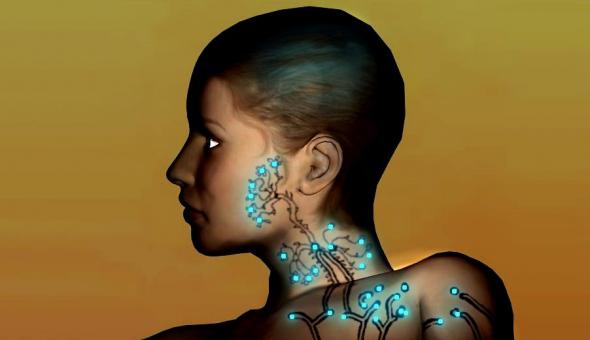BY LETTER
Living Tattoo
Technology > Application > Augmentics
Culture and Society > Daily Life
Technology > Application > Everydaytech
Technology > Technology Type or Material > Organic/Biotech
Culture and Society > Daily Life
Technology > Application > Everydaytech
Technology > Technology Type or Material > Organic/Biotech
Symbiotic organisms used for skin ornamentation |
 Image from Steve Bowers |
The first living tattoos were developed in the mid-Interplanetary Age and were based on specially designed organelles introduced into the skin cells in a particular location on the owner's body. These organelles caused the altered skin cells to modify their pigment such that they took on a darker or lighter tone or even changed color to a significant degree, often to shades never found naturally in the baseline human color palette. As the technology developed, a variety of techniques were developed for creating various types of living tattoo, sometimes incorporating newly discovered or synthesized proteins or (as various augmentations to the sophont eye became available) utilizing colors only
visible in the ultraviolet or infra-red portions of the spectrum. The culmination of these developments came with the development of living tattoos based on symbiotic organisms living on the surface and outer layers of the owner's integument.
In the Current Era, most living tattoos are simply pre-programmed at the genetic level to grow into the pattern or image that the owner desires and then settle down into a stable existence until their removal or natural expiration. However, the more complex (and highly prized) tattoos are far more demanding than this, requiring the owner to establish conscious control over the tattoos development via a set of specialized routines loaded to their onboard medisystem. The owner uses their onboard systems to first perceive and then literally cultivate, train, and herd the tiny organisms that make up their tattoo, causing them to grow and cluster in ways that show up as the desired image on the user's
skin. Small (less than a centimeter across) living tattoos may be created in a matter of months, but the larger examples may take years to develop and cover a significant portion of the owner's anatomy.
Living tattoos are particularly popular among Superior and low transapient engineers from the more biotech oriented civilizations such as theBiopolity or Red Star `M'pire. Considered masters of the art form, sophonts from these cultures may create entire self-sustaining micro-ecologies on themselves (or be presented with them as marks of particularly high confidence or achievement), their growth and maintenance being considered symbolic of the techniques used to create planetary and habitat biosystems. At the largest scale, several S3 transapients within the Biopolity have established biospheres on their outer surfaces whose natural processes result in the creation of complex animated images that gradually change and progress across their surfaces (as seen from orbit) as the ecology changes with the course of the seasons.
Perhaps not to be outdone, a number of high-level vec and ai engineers have also taken to the practice of creating living tattoos, but using only hylonano and microtech to create tiny mechosystems (often radiating pleasing "colors" in radio or even x-ray wavelengths) on their outer shells or casings.
Related Articles
Appears in Topics
Development Notes
Text by Todd Drashner
with additions by AI Vin, Ryan B, and Stephen Inniss
Initially published on 26 September 2012.
with additions by AI Vin, Ryan B, and Stephen Inniss
Initially published on 26 September 2012.






